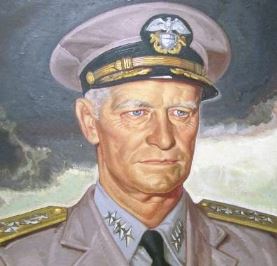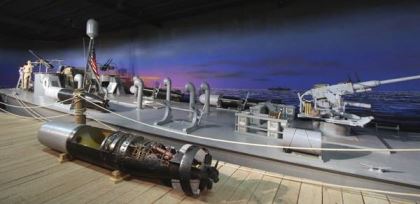Return to the days of World War II by exploring this impressive collection in Fredericksburg, Texas.
By Mark Quasius, F333630
November 2013
The United States and its allies waged war on two fronts during World War II: Europe and the Pacific. But the longest struggle for America was with Japan in the Pacific. The Pacific Theater covered a vast area, and its defense depended on all branches of the military. Operations there cost more than 100,000 American lives. President Franklin Roosevelt chose Admiral Chester Nimitz to be the commander of the naval forces after the attack on Pearl Harbor.
Nimitz did not grow up alongside an ocean, or even a lake. He spent his childhood in Fredericksburg, Texas. The founders of the museum chose to honor Admiral Nimitz by creating a museum of the Pacific War right in his hometown.
Location
The National Museum of the Pacific War is a massive campus of buildings and areas devoted to the Pacific War. The main entrance is at the George H.W. Bush Gallery. This is the place where the vast majority of the exhibits are on display. Surrounding this building are the Admiral Nimitz Museum, the Plaza of Presidents, the Japanese Garden of Peace, the Memorial Courtyard, and the new Nimitz Education and Research Center. The Pacific Combat Zone is located two blocks to the east. The entire 6-acre site is handicapped-accessible, and free admission is offered to any World War II veteran.
Fredericksburg is a small, welcoming town in the south-central portion of Texas called the Hill Country. The museum site is located one block east of Main Street in downtown Fredericksburg and is surrounded by places to dine and shop, as well as the Fredericksburg Visitors Center. The main entrance is easily identifiable with a submarine conning tower and naval gun displays right out front near free, on-street parking. Additional parking is available in the Fredericksburg Chamber of Commerce Visitors Center lot at Austin and Lincoln streets.
George Bush Gallery
Begin your visit inside the 33,000-square-foot George Bush gallery, named after the 41st U.S. president who flew a TBM Avenger torpedo bomber during the war. The museum’s interpretive story begins with Japan’s political background and aspirations, as well as the events leading up to war. The exhibits are arranged in chronological order to start you at the Pearl Harbor attack on December 7, 1941, and America’s entry into the war. One of the four Japanese submarines that participated in the attack survived and is on display, along with a compartment door from the USS Arizona and other artifacts from that fateful day. The Doolittle Raid on Tokyo is well represented with a restored B-25 from that mission. Other aircraft and land force weaponry from both sides can be seen as your tour takes you through various scenarios. Many interactive multimedia exhibits are on display for those who want to delve into more details. The self-guided tour ends as you consider Hiroshima’s and Nagasaki’s fate and the horrific cost of victory in both lives and material.
 Admiral Nimitz Museum
Admiral Nimitz Museum
A biography is next — the story of Chester Nimitz himself. The Admiral Nimitz Museum is located on Main Street, at the opposite corner of the property. The historic Nimitz Hotel, owned by the admiral’s grandfather, is where Chester was born and raised in the late 1800s. The museum boasts a 15-foot model of the supercarrier USS Nimitz, as well as some fascinating facts. For example, in 1908, Ensign Nimitz commanded the destroyer USS Decatur, which he ran aground on a sandbar in the Philippines. A court-martial rendered a letter of reprimand, and he began to work on submarines instead. The subsequent experience gave him vital understanding needed for the Navy of the future.
Japanese Garden of Peace and Plaza of Presidents
The Garden of Peace is a gift from the military leaders of Japan to the people of the United States honoring Admiral Nimitz. Featuring stone, water, and plants, it is a replica of a garden owned by Admiral Heihachiro Togo. Togo, a great Japanese naval commander, was much admired by Nimitz. The garden is a gift from the people of Japan with prayers for everlasting peace and goodwill between the two countries.
The adjoining Plaza of Presidents features commemorative monuments, plaques, and details regarding the 10 American presidents who served during World War II.
Pacific Combat Zone
No trip to the museum would be complete without a visit to the Pacific Combat Zone. This facility consists of indoor and outdoor displays. Guided tours through the area begin in a large building with a re-creation of an aircraft carrier hangar deck complete with a TBM Avenger torpedo bomber being readied for a strike. A second area contains a dock with a PT-309, the only remaining restored PT boat to serve in the Pacific during World War II.
Outside, view a battle scene modeled after the heavily entrenched Japanese defenses at Tarawa. Artillery emplacements, anti-aircraft guns, tanks, entrenchments, and pillboxes common to that island are all re-created in detail. Re-enactments are held here several times each year. Marines land with an LVT amphibious troop carrier while a half-track and an M3 Stuart tank are used to storm the Japanese defenses. A highlight of the show is when the Marines storm the pillbox with an actual flamethrower. Black soot on the pillbox from the flamethrower gives evidence of the realism of these re-enactments. After the battlefield tour, you’ll enter a Quonset hut that is set up as a World War II field hospital, and you will learn more about the kind of medical attention available at that time.
Research Center And Gift Shop
Adjacent to the George H.W. Bush Gallery is a large gift shop containing souvenirs, related hobby crafts and models, as well as a large collection of books and media relating to the Pacific War.
The new Nimitz Education and Research Center is now open at the site with an extensive collection of documents and photos pertaining to the Pacific War. Inside are more than 3,700 recorded interviews with veterans, which help to create the most comprehensive collection of information available about this pivotal time in history.
Motorhome owners will find that the Texas Hill Country has much to offer. Many RVers frequently choose it as a destination. For anyone traveling in this area, the National Museum of the Pacific War is a must-see stop. A visit here will be both interesting and informative and will help give you a greater appreciation for what America accomplished to overcome its trials and bring an end to World War II.
Further Info
The museum is open daily except for Thanksgiving, Christmas Eve, and Christmas Day. Allow several hours to see it all. The admission fee is good for two days.
National Museum of the Pacific War
340 E. Main St.
Fredericksburg, TX 78624
(830) 997-8600
www.pacificwarmuseum.org
Fredericksburg Visitor Information Center
302 E. Austin St.
Fredericksburg, TX 78624
(888) 997-3600
(830) 997-6523
www.visitfredericksburgtx.com
Witness Guns Blazing
See tanks, explosions, landing craft, and flamethrowers as you attend a re-enactment in the museum’s Pacific Combat Zone, two blocks northeast of the museum complex on East Austin Street, on scheduled weekends. U.S. Marine re-enactors move in to capture fortified positions from Japanese defenders using equipment and tactics of the period. The museum’s living history programs are so real, observers are given earplugs!
An extra fee is charged for the 90-minute program.
Re-enactment dates for the remainder of 2013 are October 12 and 13, and November 9 and 10. Purchase tickets in advance at the George H.W. Bush Gallery or the Admiral Nimitz Museum. Sometimes walk-up tickets are available at the Pacific Combat Zone prior to the program if the re-enactment is not sold out.

